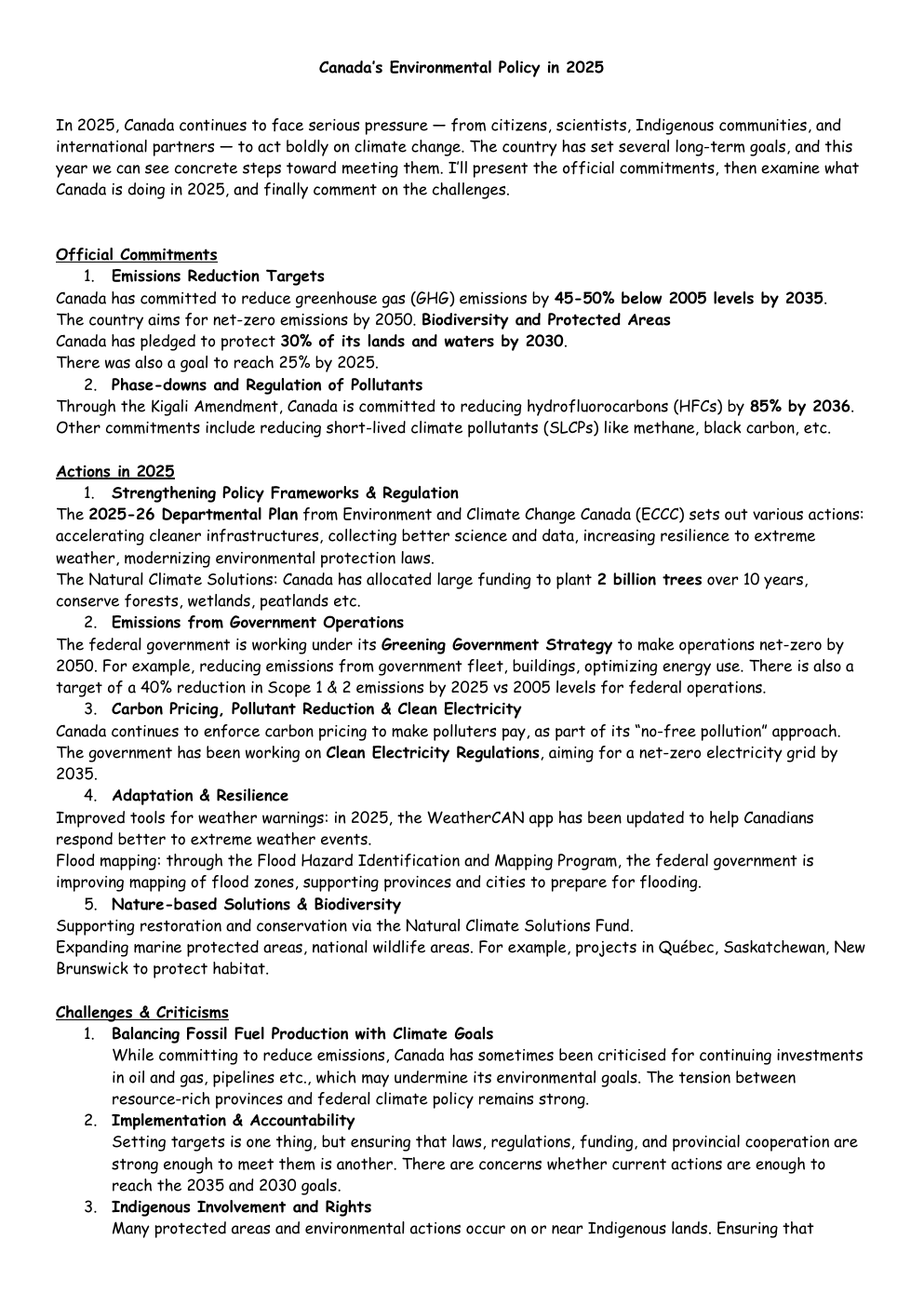Political environnemental Canada
Publié le 21/10/2025
Extrait du document
«
Canada’s Environmental Policy in 2025
In 2025, Canada continues to face serious pressure — from citizens, scientists, Indigenous communities, and
international partners — to act boldly on climate change.
The country has set several long-term goals, and this
year we can see concrete steps toward meeting them.
I’ll present the official commitments, then examine what
Canada is doing in 2025, and finally comment on the challenges.
Official Commitments
1.
Emissions Reduction Targets
Canada has committed to reduce greenhouse gas (GHG) emissions by 45-50% below 2005 levels by 2035.
The country aims for net-zero emissions by 2050.
Biodiversity and Protected Areas
Canada has pledged to protect 30% of its lands and waters by 2030.
There was also a goal to reach 25% by 2025.
2.
Phase-downs and Regulation of Pollutants
Through the Kigali Amendment, Canada is committed to reducing hydrofluorocarbons (HFCs) by 85% by 2036.
Other commitments include reducing short-lived climate pollutants (SLCPs) like methane, black carbon, etc.
Actions in 2025
1.
Strengthening Policy Frameworks & Regulation
The 2025-26 Departmental Plan from Environment and Climate Change Canada (ECCC) sets out various actions:
accelerating cleaner infrastructures, collecting better science and data, increasing resilience to extreme
weather, modernizing environmental protection laws.
The Natural Climate Solutions: Canada has allocated large funding to plant 2 billion trees over 10 years,
conserve forests, wetlands, peatlands etc.
2.
Emissions from Government Operations
The federal government is working under its Greening Government Strategy to make operations net-zero by
2050.
For example, reducing emissions from government fleet, buildings, optimizing energy use.
There is also a
target of a 40% reduction in Scope 1 & 2 emissions by 2025 vs 2005 levels for federal operations.
3.
Carbon Pricing, Pollutant Reduction & Clean Electricity
Canada continues to enforce carbon pricing to make polluters pay, as part of its “no-free pollution” approach.
The government has been working on Clean Electricity Regulations, aiming for a net-zero electricity grid by
2035.
4.
Adaptation & Resilience
Improved tools for weather warnings: in 2025, the WeatherCAN app has been updated to help Canadians
respond better to extreme weather events.
Flood mapping: through the Flood Hazard Identification and Mapping Program, the federal government is
improving mapping of flood zones, supporting provinces and cities to prepare for flooding.
5.
Nature-based Solutions & Biodiversity
Supporting restoration and conservation via the Natural Climate Solutions Fund.
Expanding marine protected areas, national wildlife areas.
For example, projects in Québec, Saskatchewan, New
Brunswick to protect habitat.
Challenges & Criticisms
1.
Balancing Fossil Fuel Production with Climate Goals
While committing to reduce emissions,....
»
↓↓↓ APERÇU DU DOCUMENT ↓↓↓
Liens utiles
- Article - The power of words - Words, a powerful political and social weapon ?
- Multiculturalisme et Canada: Why is Multiculturalism a very important concept in Canada?
- Canada Day.
- Chicoutimi 1 PRÉSENTATION Chicoutimi, ville du Canada, chef-lieu de comté de Chicoutimi, dans le sud du Québec, située au confluent des rivières Chicoutimi et Saguenay.
- To what extent can social media be a tool for the public to have their say in political matters


